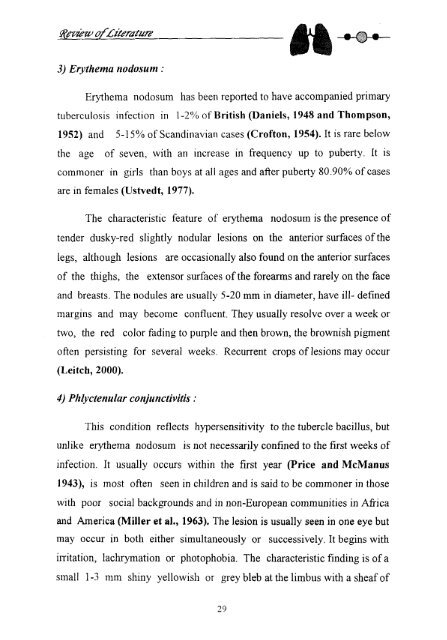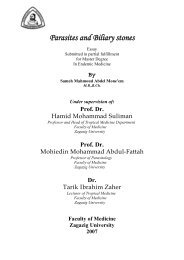Study of respiratory symptoms among sputum positive
Study of respiratory symptoms among sputum positive
Study of respiratory symptoms among sputum positive
Create successful ePaper yourself
Turn your PDF publications into a flip-book with our unique Google optimized e-Paper software.
....<br />
£fwwoj"£itertltua<br />
3) Erythema nodosum :<br />
Erythema nodosum has been reported to have accompanied primary<br />
tuberculosis infection in 1-2(1'0 <strong>of</strong> British (Daniels, 1948 and Thompson,<br />
1952) and 5-15% <strong>of</strong> Scandinavian cases (Cr<strong>of</strong>ton, 1954). It is rare below<br />
the age <strong>of</strong> seven, with an increase in frequency up to puberty. It is<br />
commoner in girls than boys at all ages and after puberty 80.90% <strong>of</strong>cases<br />
are in females (Ustvedt, 1977).<br />
The characteristic feature <strong>of</strong> erythema nodosum is the presence <strong>of</strong><br />
tender dusky-red slightly nodular lesions on the anterior surfaces <strong>of</strong>the<br />
legs, although lesions are occasionally also found on the anterior surfaces<br />
<strong>of</strong> the thighs, the extensor surfaces <strong>of</strong>the forearms and rarely on the face<br />
and breasts. The nodules are usually 5-20 mm in diameter, have ill- defined<br />
margins and may become confluent. They usually resolve over a week or<br />
two, the red color fading to purple and then brown, the brownish pigment<br />
<strong>of</strong>ten persisting for several weeks. Recurrent crops <strong>of</strong>lesions may occur<br />
(Leitch, 2000).<br />
4) Phlyctenular conjunctivitis:<br />
This condition reflects hypersensitivity to the tubercle bacillus, but<br />
unlike erythema nodosum is not necessarily confined to the first weeks <strong>of</strong><br />
infection. It usually occurs within the first year (Price and McManus<br />
1943), is most <strong>of</strong>ten seen in children and is said to be commoner in those<br />
with poor social backgrounds and in non-European communities in Africa<br />
and America (Miller et al., 1963). The lesion is usually seen in one eye but<br />
may occur in both either simultaneously or successively. It begins with<br />
irritation, lachrymation or photophobia. The characteristic finding is <strong>of</strong>a<br />
small 1-3 mm shiny yellowish or grey bleb at the limbus with a sheaf <strong>of</strong><br />
29
















